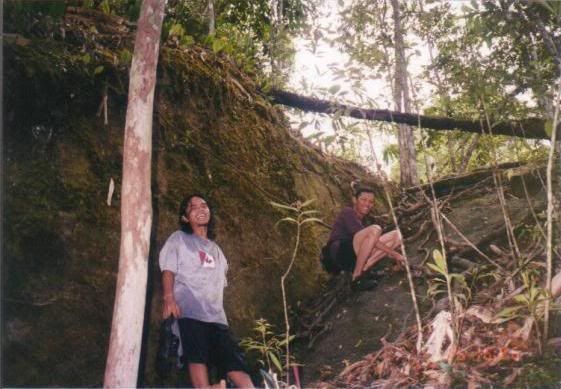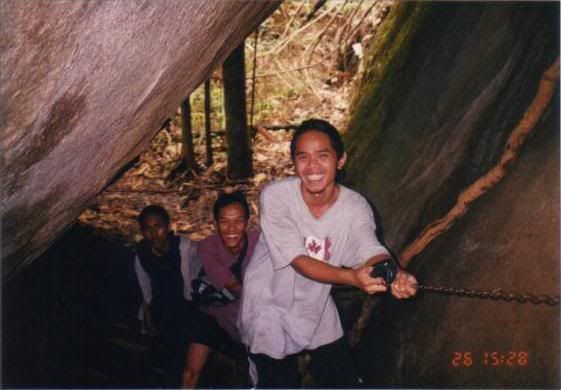 List & Ranking Gunung-Gunung Malaysia (tinggi dalam kaki/feet)
List & Ranking Gunung-Gunung Malaysia (tinggi dalam kaki/feet)
1. Gunung Kinabalu - 13,455 Sabah Kinabalu Park Sabah
2. Gunung Trusmadi - 8,669, Sabah
3. Gunung Tambuyukon - 8,462, Sabah
4. Gunung Murud - 7,946 Sarawak
5. Gunung Mulu - 7,795 Mulu Park Sarawak
6. Gunung Tahan - 7,174 Taman Negara Pahang
7. Gunung Korbu - 7,162 Ipoh Perak
8. Gunung Yong Belar - 7,156 Perak/Kelantan
9. Gunung Gayong - 7,129 Perak
10. Gunung Chamah - 7,122 Tasek Temenggor Perak/Kelantan
11. Gunung Yong Yap - 7,113 Kuala Mu, Sungai Siput Perak/Kelantan
12. Gunung Ulu Sepat - 7,089 Tasek Temenggor Perak/Kelantan
13. Gunung Batu Putih - 6,990 Kg. Sg. Woh Tapah, Perak
14. Gunung Tama Abu - 6,930 Banjaran Tama Abu Sarawak
15. Gunung Irau - 6,924 Cameron Highland Pahang
16. Gunung Benom - 6,914 Jerantut Pahang
17. Gunung Apd Runan - 6,900 Sarawak Kelabit Highland Sarawak
18. Gunung Gerah - 6,898 Perak/Kelantan
19. Puncak - 6852 6,850 Perak
20. Bukit Batu - 6,863 Sarawak
21. Bukit Batu Buli - 6,862 Banjaran Tama Abu Sarawak
22. Gunung Tumang Batak - 6,830 Perak
23. Gunung Berembun - 6,817 Perak
24. Gunung Bilah - 6,812
25. Gunung Berumbun (Wray's) - 6,808
26. Gunung Bieh - 6,800
27. Gunung Belatok - 6,800
28. Gunung Junction - 6,796 Perak/Pahang/Kelantan
29. Gunung Gedung - 6,776 Taman Negara Pahang
30. Bukit Batu Lawit - 6,712 Banjaran Tama Abu Sarawak
31. Gunung Berinchang - 6,664 Cameron Highland Pahang
32. Bukit Batu Iran - 6,620 Sarawak
33. Gunung Tangga - 6,609 Cameron Highland Pahang
34. Gunung Bubu - 5,144 Banjaran Titiwangsa, Perak
35. Gunung Swettenham - 6,434 Perak
36. Gunung Shoid - 6,387
37. Gunung Ulu Kechau - 6,380
38. Gunung Liang Timur - 6,343 Behrang Ulu/Tg. Malim Perak
39. Gunung Liang Barat - 6,342 Behrang Ulu/Tg. Malim Perak
40. Gunung Berhid - 6,334 Kelantan
41. Gunung Challi (Pondok) - 6,307
42. Gunung Siku - 6,284 Cameron Highland Pahang
43. Gunung Tok Nenek - 6,284
44. Gunung Noring - 6,197 Perak
45. Gunung Bintang - 6,110 Kedah/Perak
46. Gunung Noring East - 6,106 Kg. Kuala Balah Kelantan
47. Gunung Beremban - 6,041 Pahang
48. Gunung Basor - 6,038 Kelantan
49. Gunung Semangko - 5,984 Kuala kubu Baharu Selangor
50. Gunung Suku - 5,896 Perak
51. Gunung Kuar - 5,815
52. Gunung Ulu Kali - 5,814 Ulu Yam Baru Selangor
53. Gunung Bujang - 5,812 Pahang
54. Gunung Tiga Negeri - 5,789
55. Gunung Raya - 5,759
56. Gunung Besar - 5,737 Lasah/Sg. Siput Perak
57. Gunung Warpu - 5,724
58. Gunung Chabang - 5,612 Simpang Pulai(Kinta) Perak
59. Gunung Jasar - 5,565 Cameron Highland Pahang
60. Gunung Rajah - 5,526 Bentong, Pahang
61. Gunung Ulu Semangkok - 5,473 Kuala Kubu Baharu Selangor
62. Gunung Lotong - 5,459 Maliau Basin, Sabah
63. Gunung Bubu (Manong) - 5,437 Kuala Kangsar Perak
64. Gunung Bah Gading - 5,318 Kg. Gedung/Bidor Perak
65. Gunung Pulang - 5,259
66. Gunung Perdah - 5,173 Cameron Highland Pahang
67. Gunung Ulu Jerneh - 5,172 Kg. Kelian/ Ijok/ Selama Perak
68. Gunung Tera - 5,105
69. Gunung Tangga 15, - 5,049 Taman Negara Pahang
70. Gunung Rabong - 5,047 Gua Musang Kelantan
71. Gunung Ulu Titi Basah - 5,030 Tasek Temenggor Perak
72. Gunung Lebah - 4,992 Kg. Ulu Selim(Slim River) Perak
73. Gunung Tapis - 4,960 Kuantan Pahang
74. Gunung Ayam - 4,934 Kelantan
75. Gunung Nuang - 4,898 Pangsoon/Ulu Langat Selangor
76. Gunung Bedong - 4,818 Cameron Highland Pahang
77. Gunung Lawit - 4,982
78. Gunung Pangkin - 4,797 Taman Negara Pahang
79. Gunung Besar Hantu - 4,794 Jelebu, N. Sembilan
80. Gunung Mandi Angin - 4,790 Dungun
81. Pine Hill Tree - 4,777 Frasiers Hill, Kuala Kubu Baru Selangor
82. Gunung Ulu Merah - 4,757
83. Gunung Hijau (Maxwell) - 4,751 Taiping Perak
84. Gunung Ulu Perus - 4,700 Taman Negara Pahang
85. Gunung Bunga Buah - 4,690 Genting Highland Pahang
86. Gunung Temiang - 4,098
87. Gunung Stong - 4,664
88. Gunung Chingkai - 4,583 Kg. Jalong/Sg. Siput Perak
89. Gunung Diwangsa - 4,578 Taman Negara Pahang
90. Gunung Ulu Bakar - 4,563 Taman Negara Pahang
91. Gunung Bakar (Palas) - 4,560
92. Gunung Che Tahir - 4,523
93. Gunung Ulu Telang - 4,516
94. Gunung Gagau - 4,513 Taman Negara Pahang
95. Gunung Menyelit - 4,467
96. Gunung Talang - 4,413
97. Gunung Ulu Bakau - 4,421 Selangor
98. Gunung Inas - 4,400 Kg. Kenering, Grik, Perak
99. Gunung Penrissen - 4,360 Sarawak
100. Gunung Ulu Soh - 4,343 Tasek Chenderoh, K. Kangsar, Perak
101. Gunung Padang - 4,314 Terengganu
102. Gunung Baha - 4,294
103. Gunung Kambing - 4,288
104. Gunung Berangkat - 4,254 Perhentian Bertam Baharu Kelantan
105. Gunung Saji - 4,212
106. Gunung Ulu Tirus
107. Gunung Perlis - 4,195 Taman Negara Pahang
108. Gunung Ledang - 4,187 Asahan/Sagil/Tangkak Johor
109. Gunung Panggang Paku - 4,155Cameron Highland Pahang
110. Bukit Lata Papalang - 4,152 Kg. Tg. Pari(Baling) Kedah
111. Gunung Bujang Melaka - 4,048 kampar Perak
112. Gunung Surat - 4,031
113. Gunung Kenderong - 4,011 meter, Gerik.
114. Gunung Biong - 3,997 Kg. Baharu Sauk,Batu Kurau Perak
115. Gunung Jerai (Gurun) - 3,992 Kuala Muda Kedah
116. Gunung Reskit - 3,989 Taman Negara Pahang
117. Gunung Gajah Terom - 3,958 Terengganu
118. Gunung Bokbak - 3,934 Perak
119. Gunung Telapa Buruk - 3,913 Kg. Ulu Klawang N. Sembilan
120. Gunung Irong - 3,908 Pahang
121. Gunung Chintawangsa - 3,886
122. Gunung Kuak Rimau - 3,712 Grik
123. Gunung Kubang Badak - 3,650Kg. Surau Baling Kedah
124. Gunung Gabis - 3,627 Kg. Bkt Koman(Raub) Pahang
125. Gunung Penumpu - 3,590 Taman Negara Pahang
126. Gunung Laris - 3,527
127. Gunung Terra - 3,503
128. Gunung Peninjau - 3,471 Chemor Perak
129. Gunung Serundum - 3,462 Pancing/Kuantan Pahang
130. Gunung Lerek - 3,441 Kg. K. Sentul Pahang (Maran)
131. Gunung Kachang - 3,436
132. Gunung Kub
133. Gunung Birut
134. Gunung Tebu - 3,408 Terengganu
135. Gunung Belalai - 3,406
136. Gunung Besar - 3,398 Bekok Segamat Johor
137. Gunung Belumut - 3,313 Kg. Kahang/Kluang Johor
138. Gunung Perenggan - 3,275
139. Gunung Bekok - 3,126 Johor
140. Gunung Cherlak - 3,065
141. Gunung Datok - 2,900 Rembau N. Sembilan
142. Gunung Raya - 2,890 Pulau Langkawi Kedah
143. Gunung China - 2,890
144. Gunung Perak - 2,836 Kedah
145. Gunung Chirgoi - 2,804
146. Gunung Ulu Kemapan - 2,802
147. Gunung Chenuang - 2,788 Selangor
148. Gunung Tok Bidan - 2,763
149. Gunung Beremban - 2,753
150. Western Hill - 2,723 (Penang Hill) Pulau Pinang
151. Gunung Jua - 2,719
152. Gunung Angsi - 2,702 Kuala Pilah N. Sembilan
153. Gunung Santubong - 2,657 Sarawak
154. Gunung Ulu Baranang - 2,654
155. Gunung Ulu Kaho - 2,600
156. Gunung Besar - 2,595
157. Gunung Kapal - 2,592
158. Gunung Bayu - 2,549
159. Gunung Berantai - 2,520
160. Gunung Tampin - 2,507 Tampin Negeri Sembilan
161. Gunung Mat Chinchang - 2,339 Langkawi, Kedah
162. Gunung Pulai - 2,147 Pulai, Johor
163. Gunung Muntahak - 2,339 Kota Tinggi, Johor
164. Gunung Sumalayang - 2,018 Johor
165. Gunung Rajah - 1,890 Taman Negara Pahang
166. Gunung Lambak - 1,673 Kluang, Johor
167. Gunung Senyum - 1,594 Felda Batu 25/Jengka Pahang
168. Gunung Panti - 1,498 Kg. Lukut, Kota Tinggi/ Johor
169. Bukit Takun - 1,450 Melawati/Ulu Klang Selangor
170. Gunung Lubok Tedong - 1,420 Melawati/Gombak Selangor
171. Gunung Lepo - 1,400 Ulu Langat Selangor
172. Bukit Tabuh - 1,300 Melawati/Ulu Klang Selangor
 The rugged landscape of Kelantan’s interiors offers many exciting adventures for anyone who loves the great outdoors. From limestone hills to rushing rapids, from thick tropical jungles to cool cavernous caves, Kelantan is a pleasure to experience.
The rugged landscape of Kelantan’s interiors offers many exciting adventures for anyone who loves the great outdoors. From limestone hills to rushing rapids, from thick tropical jungles to cool cavernous caves, Kelantan is a pleasure to experience. The best way to enter the interiors of Kelantan and, at the same time, get a first-hand look at the typical village life, is to take the KTM train – once romantically known as the Jungle Train in the spirit of adventure and exploration – right through the state. One of the stops along the way is in the quaint village of Dabong, about 155 kilometers from Kota Bharu, the state capital. Dabong lies in the area dedicated as Mt.Stong State Park (formerly called Jelawang Jungle) and is situated on the fringes of Malaysia’s massive Titiwangsa range.
The best way to enter the interiors of Kelantan and, at the same time, get a first-hand look at the typical village life, is to take the KTM train – once romantically known as the Jungle Train in the spirit of adventure and exploration – right through the state. One of the stops along the way is in the quaint village of Dabong, about 155 kilometers from Kota Bharu, the state capital. Dabong lies in the area dedicated as Mt.Stong State Park (formerly called Jelawang Jungle) and is situated on the fringes of Malaysia’s massive Titiwangsa range.
















.jpg)














